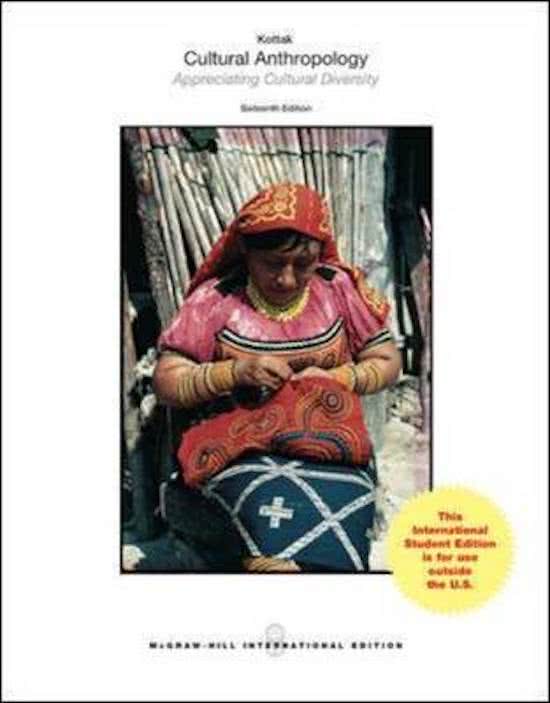Chapter Review Kottak | Cultural Anthropology 1
Week 1 / Chapter 1 and 4
Anthropology is the holistic and comparative study of humanity. It is the systematic exploration of
human biological and cultural diversity. Examining the origins of, and changes in, human biology
and culture, anthropology provides explanations for similarities and differences. There are multiple
subfields in anthropology that all consider variation in time and space. Each also examines
adaptation, which is the process by which organisms cope with environmental stresses.
Ethnologists attempt to identify and explain cultural differences and similarities and tot build
theories about how social and cultural systems work. Cultural forces mold human biology, including
our body times and images. Societies have particular standards of physical attractiveness. They
also have specific ideas about what activities, for example various sports, are appropriate for males
and females.
Week 2 / Chapter 2
Culture, which is distinctive to humanity, refers to customary behavior and beliefs that are passed
on through enculturation. Culture rests on the human capacity for cultural learning and it
encompasses rules for conduct internalized in human beings, which lead them to think and act in
characteristic ways.
Although other animals learn, only humans have cultural learning, dependent on symbols. Humans
think symbolically, arbitrarily bestowing meaning on things and events. By convention, symbols
stand for something with which it has no necessary or natural relation. Symbols have special
meaning for people who share memories, values, and beliefs because of common enculturation.
People absorb these lessons of culture consciously and unconsciously.
Culture is integrated, which means that culture is everywhere. It is integrated and patterned
through economic and social forces, key symbols, and core values. Cultural rules don’t rigidly
dictate our behavior. There is room for creativity and flexibility, diversity and disagreement within
societies. Cultural means of adaptation have been crucial in human evolution. Aspects of culture
can, however, also be maladaptive.
Ethnocentrism describes judging other cultures by using one’s own cultural standards. Cultural
relativism, which anthropologists may use as a methodological position rather than a moral stance,
is the idea of avoiding the use of outside standards to judge behavior in a given society. Human
rights are those based on justice and morality beyond and superior to particular countries, cultures
and religions. Cultural rights are vested in religious and ethnic minorities and indigenous societies.
Diffusion, migration and colonialism have carried cultural traits and patterns to different world
areas. Mechanisms of cultural change include diffusion, acculturation and independent invention.
Globalization describes a series of processes that promote change in a world in which nations and
people are interlinked and mutually dependent.
Week 3 / Chapter 3
Ethnographic methods include observation, rapport building, participant observation, interviewing,
genealogies, work with key consultants, life histories, and longitudinal research. Ethnographers do
not systematically manipulate their subjects or conduct experiments. Rather, they work in actual
communities and form personal relationships with local people as they study their lives.
Week 1 / Chapter 1 and 4
Anthropology is the holistic and comparative study of humanity. It is the systematic exploration of
human biological and cultural diversity. Examining the origins of, and changes in, human biology
and culture, anthropology provides explanations for similarities and differences. There are multiple
subfields in anthropology that all consider variation in time and space. Each also examines
adaptation, which is the process by which organisms cope with environmental stresses.
Ethnologists attempt to identify and explain cultural differences and similarities and tot build
theories about how social and cultural systems work. Cultural forces mold human biology, including
our body times and images. Societies have particular standards of physical attractiveness. They
also have specific ideas about what activities, for example various sports, are appropriate for males
and females.
Week 2 / Chapter 2
Culture, which is distinctive to humanity, refers to customary behavior and beliefs that are passed
on through enculturation. Culture rests on the human capacity for cultural learning and it
encompasses rules for conduct internalized in human beings, which lead them to think and act in
characteristic ways.
Although other animals learn, only humans have cultural learning, dependent on symbols. Humans
think symbolically, arbitrarily bestowing meaning on things and events. By convention, symbols
stand for something with which it has no necessary or natural relation. Symbols have special
meaning for people who share memories, values, and beliefs because of common enculturation.
People absorb these lessons of culture consciously and unconsciously.
Culture is integrated, which means that culture is everywhere. It is integrated and patterned
through economic and social forces, key symbols, and core values. Cultural rules don’t rigidly
dictate our behavior. There is room for creativity and flexibility, diversity and disagreement within
societies. Cultural means of adaptation have been crucial in human evolution. Aspects of culture
can, however, also be maladaptive.
Ethnocentrism describes judging other cultures by using one’s own cultural standards. Cultural
relativism, which anthropologists may use as a methodological position rather than a moral stance,
is the idea of avoiding the use of outside standards to judge behavior in a given society. Human
rights are those based on justice and morality beyond and superior to particular countries, cultures
and religions. Cultural rights are vested in religious and ethnic minorities and indigenous societies.
Diffusion, migration and colonialism have carried cultural traits and patterns to different world
areas. Mechanisms of cultural change include diffusion, acculturation and independent invention.
Globalization describes a series of processes that promote change in a world in which nations and
people are interlinked and mutually dependent.
Week 3 / Chapter 3
Ethnographic methods include observation, rapport building, participant observation, interviewing,
genealogies, work with key consultants, life histories, and longitudinal research. Ethnographers do
not systematically manipulate their subjects or conduct experiments. Rather, they work in actual
communities and form personal relationships with local people as they study their lives.




